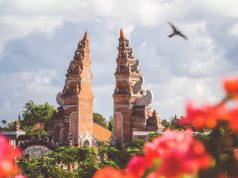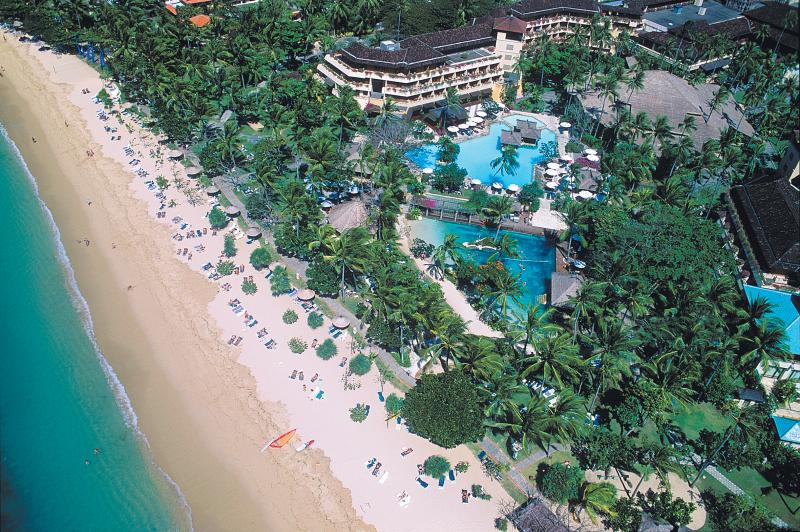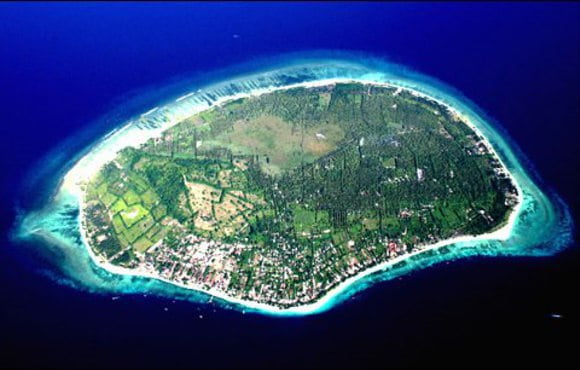The country of Indonesia is composed of 17,508 islands making up a total of 1,919,440 square kilometers. That’s a big much to take in, so we’ve compiled a simplified breakdown of Indonesia’s islands.
A Breakdown of Indonesia’s Islands
It’s a little difficult to wrap one’s head around 17,508 islands so let’s break the country down into its constituent parts – Java, Bali, Sumatra, Nusa Tenggara, Sulawesi, Maluku, Kalimantan, and Irian Jaya (the western half of New Guinea).
Java
Java is the political, geographic, and economic heart of Indonesia. Java makes up only 6% of Indonesia’s total land area, but it is home to around 60% of the country’s total population, making it the world’s most populous island as well as one of the most densely-populated places on earth.
Java is not just a modern hub – historically, Java has been home to Indonesia’s most glorious kingdoms. You can still find vestiges of some of Java’s earliest Hindu temples on the Dieng Plateau, as well as check out some amazing monuments built by the Saliendra dynasty throughout Borobudur and Prambanan.
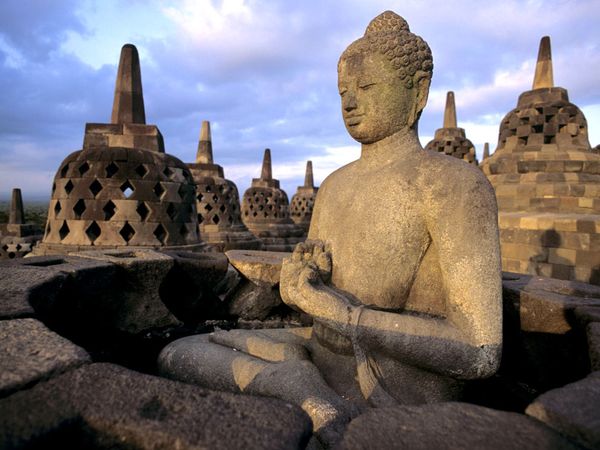 Today, Java is at the epicenter of political and economic power, generating more than half of the country’s GDP. The capital of Indonesia, Jakarta, is located in the northwest region of Java and Surabaya, the second largest city in Indonesia is located on East Java. It’s no surprise that Java is the Indonesia’s hub of cultural and economic activity.
Today, Java is at the epicenter of political and economic power, generating more than half of the country’s GDP. The capital of Indonesia, Jakarta, is located in the northwest region of Java and Surabaya, the second largest city in Indonesia is located on East Java. It’s no surprise that Java is the Indonesia’s hub of cultural and economic activity.
But city life is not all there is to Java. This remarkable island was mostly formed by volcanoes and is currently home to over 120 active volcanoes. There’s also a host of major national parks offering a splendid array of flora and fauna.
Java Must-Sees:
- The 18th century city of Yogyakarta, the cultural center of Java.
- Borobodur, which is over a thousand years old and one of the greatest Buddhist relics in South-East Asia. It is constructed of over a million and a half stones, with nearly 6 km of reliefs and 300 statues of Buddha.
- Prambanan. The Hindu temples of Prambanan village are the best remaining examples of Java’s period of Hindu cultural development and the second most impressive archaeological site after Borobodur
- Genung Bromo (2,392m), an ancient crater with four peaks rising from it and the most popular climb in Java.
- Dieng Plateau is a giant volcanic crater and home to an ancient settlement of temples dating back to the 8th century. It’s a must-see for off-the-beaten-path travelers who love nature and history.

Bali
Chances are, you heard of Bali before you heard of Indonesia. There’s no denying it – Bali is a major attraction. In fact, more tourists visit Bali than any other place in Indonesia. It’s no surprise, either – Bali is simply beautiful.
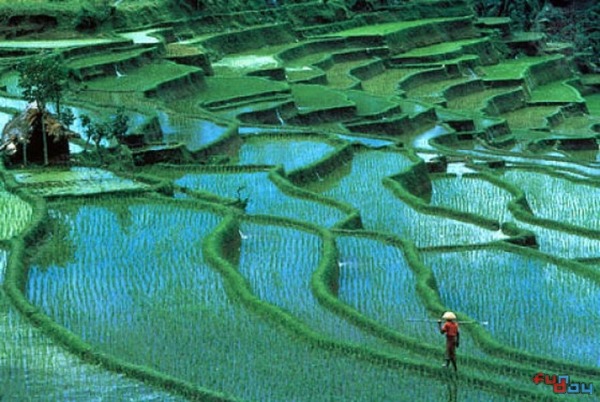
An island paradise full of lush jungles, majestic volcanoes, spectacular rice fields, and breathtaking beaches. The much-publicized Bali bombing in 2002 put a dent on Bali’s booming travel industry, but not for long – it’s back on track as one of the world’s most popular beach destinations.
Bali Must-Sees:
- Kuta is Bali’s biggest party destination. It is very tourist-y and very loud. But it does offer a lot in the way of hotels, restaurants, shops and nightclubs…if you can brave the Spring Breakers, traffic, and street hawkers. If you’re looking for an unspoilt beach getaway, Kuta is not for you. On the other hand, if you’re looking to party it up and get drunk off Arak – Kuta is the place to be.
- Ubud, the cultural centre of Bali. Full of lush jungles, Ubud makes an ideal getaway for anyone seeking a natural solace – as well as a thriving center of yoga and other spiritual retreats.
- The craft villages of Batubulan for stone-carvings, Celuk for silver, Sukawati for the art market, Batuan for painting and Mas for woodcarving.
- Seminyak for high-end resorts and black sand beaches.
- The volcanoes Genung Agung and Genung Batur, plus the spectacular coast along Tanjung Bukit and Nusa Penida.
- The temple of Puru Ulun Danu, one of the most important temples in Bali, dramatically situated on the rim of a crater.
- A local cremation. These are dramatic affairs and tourists are often welcome.
Sumatra
Ahh, Sumatra. This is a splendidly beautiful island with an extraordinary abundance of natural resources, diverse wildlife, breathtaking natural scenes, astonishing Islamic and colonial architecture, as well as some of the best national parks in all of Indonesia.

It’s also the 4th largest island in the world, measuring over 2,000 kilometers long. That makes it twice the size of Britain and a third larger than Japan. Yet, despite its gargantuan size, it is home to less than 25% of Indonesia’s population.
Although not very populated, Sumatra is crucial to the Indonesian economy – over 60% of the country’s total petroleum and gas production comes from this island and its surrounding seas.
Sumatra Must-Sees:
- The Orang-utan Rehabilitation Centre just outside Bukit Lawang.
- Genung Leuser National Park, one of the largest National Parks in Indonesia. There are tigers, rhinoceros, elephants and orang-utans, plus lots of primates such as gibbons and the white-breasted Thomas Leaf Monkey. There are also over 3,000 species of plants and 300 bird species.
- Danau Toba, the largest lake in South-East Asia and one of Indonesia’s most spectacular sights. It occupies the caldera of a giant volcano that collapsed in on itself after a cataclysmic eruption about 100,000 years ago. It covers an area of 1,707 square km and the water is 450m deep in places.
- The hill town of Bukittinggi, 930m above sea level on the Ngarai Siank Canyon and surrounded by volcanoes.This town is a center for Minangkabau culture.
Nusa Tenggara
Nusa Tenggara means “South East Islands” in Bahasa Indonesia. The Nusa Tenggara islands consists of over 500 islands and are different from the rest of Indonesia. The islands start from Lombok in the west and stretch all the way to Timor. The more east you go, the drier it becomes until you reach parts that are more dry and barren like Australia than like the jungle-clad tropics of the rest of Indonesia.
Most travelers come to Indonesia for Bali and never wander toward Lombok and beyond to the Nusa Tenggara islands, but these islands are some of the most fascinating parts of Indonesia. For example, the Komodo National Park is within Nusa Tenggara and is the only place in the world where you’ll see Komodo dragons in the wild.

Only about 4% of Indonesia’s population live on the Nusa Tenggara islands and among this small population, there is a great diversity of different languages and cultures – to the extent that it’d be difficult to think of all these people as one group. The residents on these islands also tend to be poorer than those elsewhere in Indonesia.
Nuga Tenggara Must Sees:
- Lombok is Bali’s next-door neighbor, yet still hidden in obscurity compared to the world-wide fame of Bali. This is good news for you if you’re on the lookout for beach-side serenity – Lombok is home to quiet beaches, crystal clear waters, and white, white sands. It also has a towering volcano, Gunung Rinjani and interesting crafts.
- Komodo and Rinca islands, home of the famous Komodo dragons – 3m long and weighing 100kg – the largest lizards in the world. This is the only place in the world you can see Komono dragons in the wild and a must-visit if you’re going to be around these parts.
- Sumba, which has the most intact traditional culture in Nusa Tenggara. It is best-known for its spectacular ikat weaving, fascinating megalithic tombs and the annual often-violent Pasola festivals which involve mock battles between teams of armed horsemen.
- The volcanic island of Flores, famous for the spectacular crater lakes at Kelimutu which change colour every now and then.

Sulawesi
Sulawesi
Formerly known as the Celebes, Sulawesi lies between Kalimantan and Maluku. A glance at any map of Sulawesi immediately highlights the island’s strangest attribute – its shape. The island has four ‘arms’ which radiate from a mountainous core and it has been described as looking like an orchid, a deformed spider, a giant crab and even a mutant starfish! Despite covering an area nearly as great as Britain, no place is more than about 40 km from the sea. It is the third largest of the so-called Greater Sundas, with a land area of 227,000 square km and a population of 13 million.
Don’t miss:
- Tana Toraja, home of the Toraja people and Sulawesi’s most popular tourist attraction. The Toraja people are famous for their unique culture, distinctive architecture and colourful ceremonies – in particular, their burial practices.
- Lore Lindu National Park. Covering an area of 250,000 hectares, this large and remote national park has barely been touched by tourism. It has a wide range of habitat and is most famous for its huge variety of birds.
- Danau Poso, Indonesia’s third largest lake, with its famous annual Festival Danau Poso in late August. Villagers from far-afield gather for a colourful celebration of culture, with dancing, song, traditional sports and other activities.
- The reefs around Pulau Bunanken for some of the best diving and snorkelling in Indonesia.
Maluku
Maluku, formerly known as the Moluccas, is not so much a province as an archipelago. It sprawls across 851,000 square km, of which only one tenth is land, and consists of over 1,000 islands. Their total population is only 1.9 million.
Although the islands are very much at the edge of the Indonesian world, both geographically and economically, they are historically extremely significant. These were the fabled ‘Spice Islands’ to which Indian, Chinese, Arab and later, European traders, came in search of the cloves and nutmeg which grew only there.
Don’t miss:
- The Banda Islands, with magnificent forts, a volcano, stunning coral reefs and beaches and the ideal place for diving and snorkelling.
- The Kai Islands (also known as the ‘Thousand Islands’) with some of the best beaches east of Bali.
Kalimantan(Indonesian Borneo)
Kalimantan is a huge, thinly-populated territory of swamps, jungle, mountains and rivers. Borneo, of which Kalimantan forms the major part, has always held a mystical fascination for westerners. It was a vast, isolated, jungle-covered island, where head-hunters ran wild, and which, if romantic myths were to be believed, was rich in gold and diamonds. It is the third largest island in the world (after Greenland and New Guinea) and is divided between three countries – Indonesia, Malaysia and Brunei. Kalimantan’s 549,000 square km (nearly 30% of Indonesia’s total land area) has just 5% of the country’s population (about 9.5 million), most of which is concentrated in a handful of coastal cities. The interior is populated by various Dayak tribes, whose villages are scattered along the riverbanks. Although Kalimantan has huge tracts of virtually uninhabited land, parts of the island are heavily industrialized and it is the main producer of oil and timber in Indonesia.
Kalimantan is one of the least visited parts of Indonesia, so it’s a great place to ‘get off the beaten track’ and for those who like their travel ‘rough’!
Don’t miss:
- The Orang-utan Rehabilitation Centres at Tanjung Harapan and Camp Leakey within Tanjung Puting National Park. These are probably the best in Indonesia.
- River travel along the Sungai Mahakam (Mahakam River).
- The floating market at Banjarmarsin on the Barito River. (There are plenty of food canoes as well!)
Irian Jaya
Irian Jaya comprises the western half of the island of New Guinea – the world’s largest island after Greenland. It is Indonesia’s largest, most remote, and least populated province, with large areas yet to be explored. The province is also one of the country’s newest and was only ‘acquired’ after the Dutch surrendered control of it in the 1960s.
Irian Jaya has a population of under 2 million, and is nearly twice the size of Britain and three times larger than Java and Bali combined. It contains the highest mountain in Indonesia – Puncak Jaya (5,050 m) which is usually snow-capped. Since the province is covered in vast tracts of remote and rugged country, travelling here is a serious proposition with many areas only accessible on foot. (And you will definitely need a guide!)
Don’t miss:
- Baliem Valley. This is Irian Jaya’s major tourist attraction with its unique culture and trekking opportunities. The Dani people live here and Dani men still wear penis sheaths despite the government’s campaign in the 1970s to eradicate them.
- Pulau Biak, popular for its beaches, diving and Second World War relics.
- The Asmat region, a huge area which remains almost completely undeveloped and one of the truly unexplored regions left in the world. Home of the Asmat people, famous for their wood-carvings.
If you find the website helpful we would appreciate if you support us by clicking on the related Ads that Google provides you around the pages.



